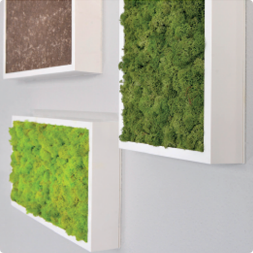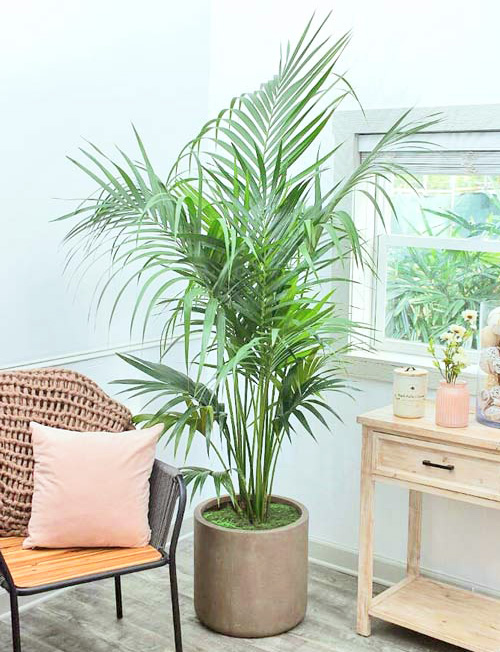The Complete Kentia Palm Care Guide
Ahh, the Kentia Palm. Elegant and dignified, the Howea forsteriana was one of the first palms ever cultured for use as an indoor plant. This majestic plant is one of the most resilient members of the palm family and immediately transforms any space into a tropical paradise. Originally propagated in Hawaii with a soil media of crushed lava rock, the Kentia offers long-lasting beauty with little fuss and a very low-maintenance care routine. It’s the perfect palm for adding an exotic touch to any home or building that will create a scene straight out of a tropical vacation!
The Kentia Palm is a real head turner with its tall, feathery fronds that can grow up to a foot in length. This palm is an ideal choice to show off indoors because of how tolerant and care-free it is- they’re easy to take care of, easy to adapt to new environments, and have we mentioned they’re easy on the eyes? In their native habitat off the coast of Australia, these majestic palms can easily reach heights of 30 feet tall. Here at Plantz, however, they come in a variety of different sizes ranging from 2-6 feet tall. Whichever size you go for, we can guarantee you will not be disappointed adding the Kentia Palm to your interior design.
While these palms are more forgiving than their family members (really, they’re practically people-proof), they still deserve the love and care needed to grow into the icon of tropical style that they are.
Kentia Palm Watering
When it comes to keeping your Kentia happy, think tropical conditions. This plant prefers to be well-hydrated but never soggy, as overwatering can lead to root rot. Since the Kentia Palm is adapted to the porous lava rock soil of Hawaii, it’s actually rather hard to overwater compared to most other houseplants. Regardless, it’s always best to use some sort of soil probe, such as our Soil Sleuth to ensure you’re only watering when your Kentia really needs a drink. Remember- it’s always better to miss a watering than to overdo it and cause your plants to drown in soggy soil conditions.
When your Kentia is good and ready for some H2o, make sure to water it thoroughly around the entire soil surface. Always allow the soil to dry out completely before the next watering to avoid possibly drowning your plant. Your Kentia may become thirstier in the warmer months, requiring weekly waterings to stay happy and healthy. In the winter, the palm will usually only need a good dose of H2o every couple of weeks or so.
Lighting for Your Kentia Palm
The Kentia Palm is just as easygoing when it comes to lighting as it is to watering. This plant has a much stronger tolerance for lower light conditions than other palms, making it the go-to choice for adding those summertime vibes indoors. While the Kentia can tolerate some pretty shady spots throughout the house, they really grow best and thrive in medium to bright light. Whether placing your new palm in a low-light corner or near a sunny south-facing window, make sure the light is always filtered and the palm is never in direct sunbeams as the intense light will burn those beautiful green fronds.
Temperature Requirements
Remember- think tropical conditions when caring for your indoor palm. Like most native tropical plants, this palm prefers warmer temperatures and high humidity. Similar to their lighting conditions, the Kentia Palm is quite tolerant of their temperatures as well- they can put up with temperatures as low as 25° and as high as 100°! While their temp range is quite impressive, they will always perform better and be healthiest in temperatures ranging between 65° and 85°.
Since the Kentia Palm is tropical in nature, it really thrives in environments with higher humidity. To keep your palm feeling nice and cozy in their new home, we recommend misting the leaves with a spray bottle a couple of times each week. If you’re more of a forgetful plant parent, you can also place your Kentia in a bathroom that has enough natural sunlight and is big enough for a gorgeous palm of this size. Whenever you shower or take a bath, the water will create a humid environment for the palm leaving you with one less worry and one happier plant!
Nutrition
Here at Plantz we make sure your new green friends are well-fed and nourished before they arrive to you, so you will not need to feed your Kentia Palm for at least six months after you get it. After that, it’s important to feed your new palm monthly during the growing seasons of spring and summer with liquid fertilizer or a specially formulated palm fertilizer. Your palm won’t need any fertilizer through the winter months, so fertilizing is usually just seasonal.
Common Problems of the Kentia Palm
The biggest issue when it comes to little critters on your Kentia Palm is scale. These insects will show up as little brown bumps on the stems or leaves of the plant, and one of the most visible indicators of scale is a blackish mold. Luckily, these insects can be wiped off with a little bit of pressure.
Like many indoor plants, you should also be on the lookout for mealybugs and spider mites on your Kentia. Both of these pests suck the juices from your precious palms, and if left untamed can end up killing your plant as well as spreading to other houseplants in your collection. Instead of treating these pests with alcohol-containing products, opt for an insecticidal soap instead so you don’t dry out the delicate leaves. Saturate all of the fronds with the soap mixture once a week until your pesky bugs are gone for good.
With the right amount of attention and love, the Kentia Palm will create a permanent tropical oasis for you to enjoy for many years to come. Contact us today and we’ll get you matched with the perfect palm for your space!



















